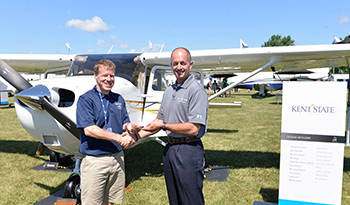
Cessna Aircraft Company recently delivered a new Cessna Skyhawk 172 as part of an agreement recently signed with Kent State University. The multi-year agreement includes initial purchase of a new Skyhawk aircraft, product support, training and Kent State’s commitment to purchase new primary trainer aircraft solely from Textron Aviation to update its flight training fleet. Kent State University, in Kent, Ohio, currently operates 17 Skyhawk aircraft as the university’s primary flight trainer.
“We are excited to expand our relationship with Kent State University as it continues to update its training fleet and advance its aeronautics program,” said Doug May, vice president, Piston Aircraft. “Kent State has been training pilots in Skyhawks for more than 30 years, further demonstrating the strength of the platform and its leadership as the world’s most successful trainer.”
Doug May presented the keys to the new aircraft to Kent State University at Textron Aviation’s static display at the Experimental Aircraft Association (EAA) AirVenture in Oshkosh, Wisconsin.
“We are very excited to accept delivery of this Skyhawk; our seventh similarly equipped aircraft in the past four years,” said Maureen R. McFarland, senior academic program director, Aeronautics at Kent State University. “We have operated Skyhawk aircraft as our primary trainer since the early 1980’s and Kent State University is very familiar with the quality, reliability and cost effectiveness of the platform. We’ve been fortunate to establish a solid relationship with an outstanding company whose values, standards and qualities of excellence match our own. We look forward to working closely with Textron Aviation in the coming years.”
Kent State University has been training pilots through its Flight Technology Program since 1967. With students in attendance from over 26 states and four different countries, Kent State’s Aeronautics Program provides a comprehensive, systems-oriented education that produces highly competent professionals to operate the National and Global Airspace System into the 21st century and beyond.


